6-Day Northern Spain Itinerary: From Bilbao to Santiago de Compostela by Train
Spain is one of the world’s most visited countries. While the usual images that travelers associate with the Southern European nation typically revolve around Andalucian white towns, paella or the unique architecture in Barcelona; there is a side to Spain that travelers often miss – and that is its northern coast. I recently went for...Read More »

Spain is one of the world’s most visited countries. While the usual images that travelers associate with the Southern European nation typically revolve around Andalucian white towns, paella or the unique architecture in Barcelona; there is a side to Spain that travelers often miss – and that is its northern coast.
I recently went for a trip in the northern regions, starting in the Basque Country and ending in Galicia and the contrast between that and more popular regions such as Andalucia, Valencia, Barcelona or even Madrid couldn’t be any greater. The regional variations extend to the architecture, the cuisine and the landscapes. It is just so much greener in the north that I often had to pinch myself to convince I am still in Spain.
In this guide, I aim to share my Northern Spain itinerary from Bilbao to Santiago de Compostela, which can be done by train or bus. I personally went on a 6-day/5-night train ride through the Costa Verde Express which allowed for excursions in these places through a combination of train or bus. The below itinerary can also be done independently using a combination of public trains, buses and car hire.
When traveling by train or at the countryside, do note that the wifi onboard can be unstable so I also had roaming mobile data during my trip. Jetpac’s Globetrotter e-sim allows for data roaming in 50 destinations through an easy installation process.
Day 1: Bilbao
Visit Guggenheim Museum

guggenheim museum
Begin the trip with a visit to the world-renowned Guggenheim Museum. I was personally awed by the remarkable architecture of this titanium-clad building designed by Frank Gehry that I enjoyed just sitting on a bench at the opposite side of the river for a full view of the structure. Inside, one gets to explore the vast collection of modern and contemporary art from renowned artists such as Picasso, Yayoi Kusama, Warhol and Jeff Koons. The museum is the most popular attraction in Bilbao and it is recommended to arrive early to avoid crowds. The museum opens at 10AM.
Get Lost in the Casco Viejo

casco viejo of bilbao
After visiting the Guggenheim Museum, it’s a 20-minute walk along the riverfront to the charming streets of Bilbao’s old town, known as Casco Viejo. This historic district is home to a variety of shops, bars, and restaurants, making it a perfect place for a leisurely lunch and some shopping. Don’t miss the stunning Catedral de Santiago, a 14th-century Gothic-style church and the Mercado de la Ribera, a bustling market with local produce, seafood, and pintxos bars. Enjoy the rest of the afternoon exploring the narrow streets and plazas of Casco Viejo.
Tip: For cheaper pintxo options, head to the food court of Mercado de la Ribera where you can choose among dozens of these light bites at a cheaper price.

teatro arriaga
If you have time, you can also catch a performance at the stunning Teatro Arriaga or you can participate in a guided tour of the interiors. Two buildings away from the theater is the Biblioteca Central de Bidebarrieta, an impressive showcase of 19th century architecture with a grand staircase and Instagram-worthy reading room with stained glass windows.
After having your fill of Bilbao, you can head to Bilbao Station to catch a bus to Santander (approximately 1hour 45 minutes).
Day 2: Santander
Enjoy El Sardinero Beach
Santander is known for its sardines and the fish’s importance is obvious at the El Sardinero Beach, a popular spot among locals and tourists alike. With its golden sand, clear water, and stunning views, it is a perfect place to bask in the sun or take a refreshing dip in the sea. There are several restaurants and cafes nearby where you can grab a bite to eat and enjoy the view. The Michelin-starred Restaurante El Serbal is a great place to chill while enjoying the view of the beach. Their set menus include specialties of the region – fresh fish and beef.
Explore Magdalena Peninsula
Next, head to the Magdalena Peninsula, a must-see attraction in Santander. Here, you’ll find a mix of natural beauty, historic monuments, and scenic views.
First, visit the Palacio de la Magdalena, a beautiful early 20th-century palace that once served as a summer residence for the Spanish royal family escaping the unbearable heat of Madrid. Be sure to take a guided tour to learn about its history and architecture.
Then, explore the surrounding parkland, which features diverse flora and fauna, as well as picturesque trails for walking or jogging.
Finally, pay a visit to the Magdalena Maritime Museum to delve into the region’s maritime history. The museum offers a unique glimpse into the lives of fishermen, sailors, and explorers who once sailed the waters around Santander.
Day 3: Santillana del Mar & Altamira Caves
Visit Altamira Museum and Replica Cave

altamira cave
On the third day of the trip, it’s time to explore the Altamira Museum and Replica Cave. This museum provides a unique opportunity to experience and learn about prehistoric life. The highlight of the visit is the replica of the famous cave, where visitors can see some of the most well-preserved examples of Paleolithic art.
Start the day by heading towards the Altamira Museum, located near the town of Santillana del Mar. It takes roughly 10 to 20 minutes to drive to Altamira from Santillana del Mar. Once you reach the museum, take your time to explore its exhibits, which showcase the timeline of human evolution and the artistic skills of the prehistoric inhabitants of the region. While visiting the actual caves is now subject to balloting, the museum has an extremely realistic replica of the cave including the prehistoric paintings. You can also walk to the actual site of the caves, although you’re only allowed to survey the real cave from a few meters away.
Wander Through Santillana del Mar
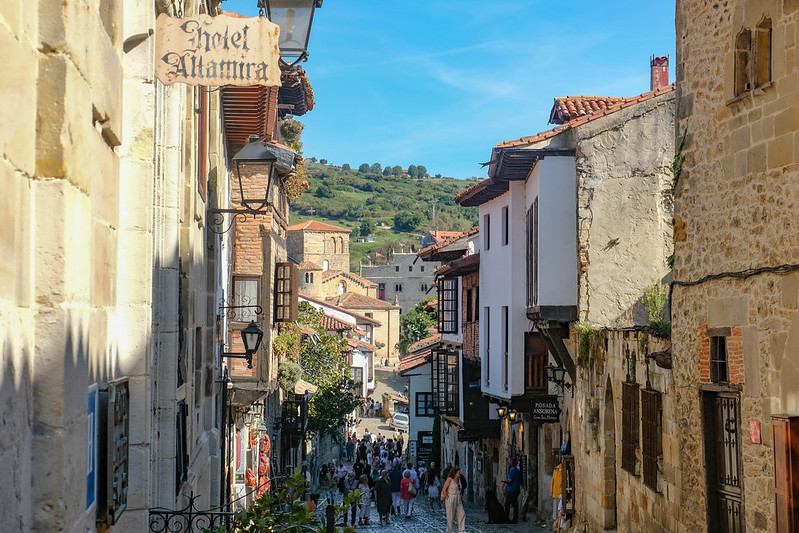
santillana del mar
After visiting the Altamira Museum, continue your journey by wandering through the charming town of Santillana del Mar. This historic town has been dubbed “The Town of Three Lies” because it is neither a Saint (Santa), nor flat (llana), nor has it a sea (sea = mar) nearby. The narrow cobbled streets and well-preserved medieval buildings give the town an enchanting atmosphere. Only two decades ago, Santillana del Mar was still primarily an agricultural town and some of the beautiful stone buildings used to be barns for farm animals. Do not miss visiting these popular sites:
- Colegiata de Santa Juliana: A stunning Romanesque-style church and monastery dating back to the 12th century.
- Casa del Aguila y la Parra: A beautiful example of a Baroque-style palace with an ornately decorated facade.
- Plaza Mayor: The central square of Santillana del Mar, surrounded by picturesque houses and local shops.

As you walk through the town, take some time to sample local specialties, such as sobaos, a traditional Cantabrian cake. The cobblestone pedestrian-only streets house art galleries, craft shops, and pottery studios that contribute to Santillana del Mar’s unique, artistic flair. For a nice meal, you can head to the restaurant of the Parador de Santillana Gil Blas for hearty Cantabrian stews.
Tip: As there is a lot of navigating involved, you’d probably want to have mobile internet with plenty of data available. Save the hassle of finding a sim card from the city or airport by availing of Jetpac’s E-Sim. Their Globetrotter plan which costs S$35 for 10gb covers Spain and you don’t have to manually insert a physical sim to get mobile data while on the road!
Day 4: Picos de Europa & Llanes
Explore Picos de Europa National Park
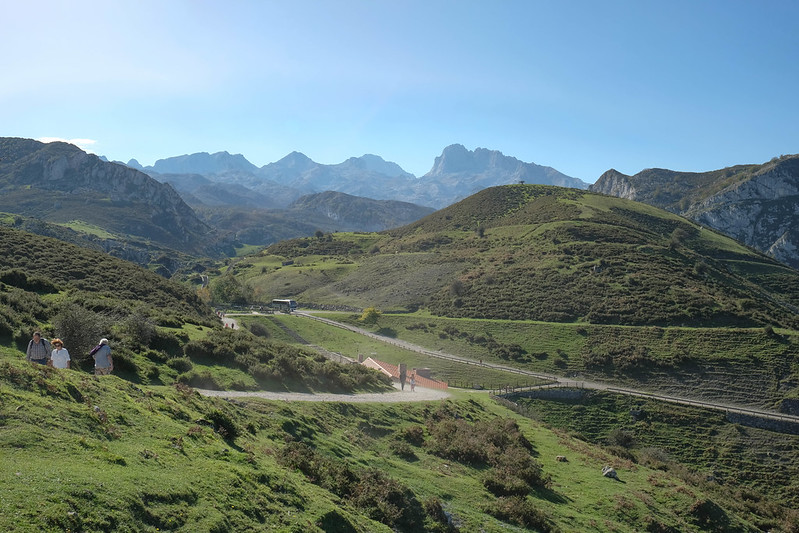
picos de europa
On the fourth day, venture to the stunning Picos de Europa National Park, known for its dramatic mountain scenery and rich biodiversity. The landscape here carries an almost alpine quality, complete with cows grazing on the fields and jagged peaks in the distance. When I did the Northern Spain trip recently, I found Picos de Europa to be my favorite stop!
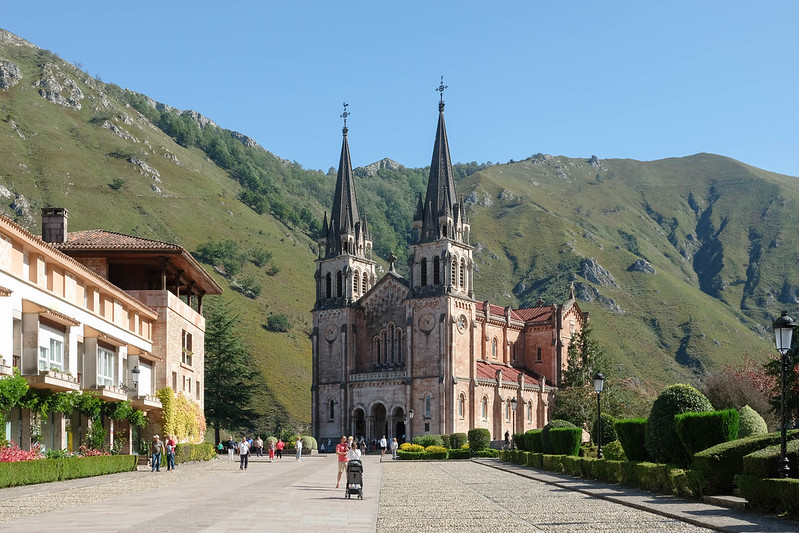
sanctuary of covadonga
You can choose to hike various trails, such as the Ruta del Cares or Ruta de los Lagos de Covadonga. I personally went for the Lagos de Covadonga route as I thought lakes were more scenic. My group also went to the Sanctuary of Covadonga after so the latter was the more convenient route for us.
Relax in Llanes

llanes
After spending the day admiring Picos de Europa’s natural beauty, it’s time to head to Arriondas and catch the train to the coastal town of Llanes. With its colorful houses and charming streets, Llanes provides the perfect setting to unwind. One of the highlights of the town is Playa de Toro, a picturesque beach known for its unique rock formations. Travelers can take a leisurely stroll along the shoreline, soak up the sun on the golden sands, or perhaps enjoy a refreshing swim in the Cantabrian Sea. In the evening, visitors can explore the local cuisine in one of the many seafood restaurants and tapas bars throughout the town.
Day 5: Oviedo, Gijon & Luarca
Visit Oviedo’s Cathedral

From Llanes, it’s a 1.5 hour bus ride or 1.75 hour train ride to Oviedo. The bustling city of Oviedo in Asturias is known for the impressive Oviedo Cathedral. This stunning Gothic-style cathedral dates back from the 14th century and features an eye-catching tower that dominates the city’s skyline. As you explore the cathedral’s interior, take note of its unique architectural elements and historical artifacts, such as the Holy Chamber, which houses an important relic – the Holy Shroud which is said to be the cloth used to wrap around the head of Jesus Christ after he was crucified.
After visiting the cathedral, take a stroll around Oviedo’s charming old quarter. Here, you can admire the blend of architectural styles and visit other historic landmarks, such as the Velarde Palace and the Town Hall.
Stroll Along Gijon’s Beachfront
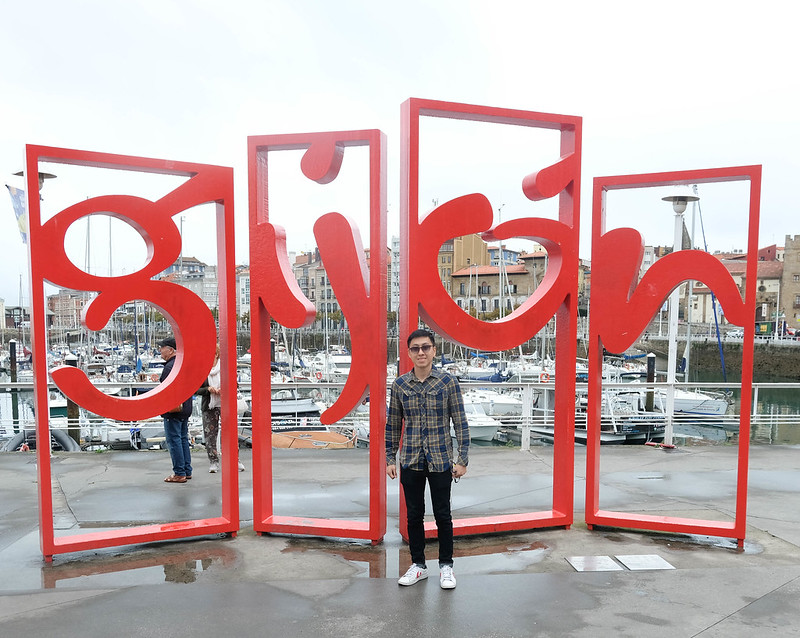
Next, make your way to the coastal city of Gijon, just 30 minutes away from Oviedo. Slightly larger than Oviedo, Gijon is known for its beautiful beaches and vibrant atmosphere. Start by taking a leisurely stroll along the Cimavilla Peninsula, which connects the city’s old town to the main beachfront area. This area of Gijon is filled with Roman-era ruins, including ancient baths and wells that are displayed publicly like an open museum.
Experience Luarca’s Harbor
End the day by taking the train from Gijon to Luarca. As the train pulls into the station, you’ll get a panoramic view of the picturesque harbor of this charming coastal town in Asturias. Take a stroll along the marina and enjoy the sight of colorful fishing boats docked against the backdrop of white-washed buildings. Have a hearty breakfast at one of the local cafes before exploring the quaint streets of this charming town.
Day 6: Ribadeo, Viveiro & Santiago de Compostela
Cross the Eo Estuary to Ribadeo

The next morning, take the train to Ribadeo where you’ll be greeted by views of the scenic Eo Estuary as you approach the town. This estuary marks the natural border between Asturias and Galicia. Ribadeo is a coastal town steeped in history and its old town offers a plethora of beautiful buildings and landmarks to explore. Highlights include Torre dos Moreno and the town’s main square, Plaza de España.

Roughly 15 minutes by car from Ribadeo is the sublime Cathedral Beach. The beach is known for its tall rock formations jutting out from the beach including the iconic cathedral windows or natural arches. To access these arches, you’ll have to visit the beach when it’s low tide.
Explore Viveiro’s Historical Center
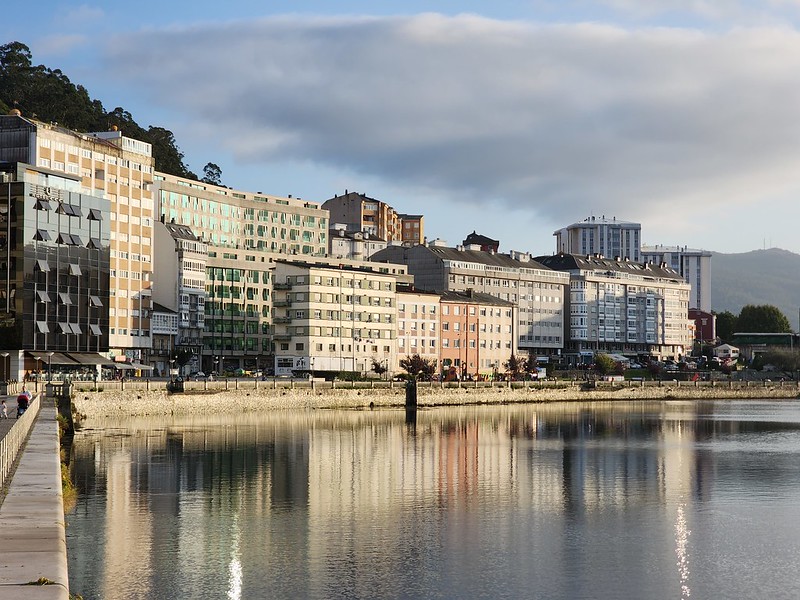
viveiro
From Ribadeo, continue your journey westward to the town of Viveiro, renowned for its rich history and remarkable architecture. Stroll through the well-preserved medieval city center, taking in the beautiful plazas, churches, and monuments. Notable sites include Santa María del Campo Church and the San Francisco Bridge.
Arrive in Santiago de Compostela

santiago de compostela
Finish your day by arriving at Santiago de Compostela, the final destination on this six-day itinerary. Santiago de Compostela is an important city for pilgrims and is the end point of the Camino de Santiago or the St. James Way, an 800 kilometer long walking trail that starts from the Pyrenees in France and which normally takes s few weeks to complete on foot.
Check out the city’s massive cathedral. Attending mass here is a bit of a thrilling experience as some sessions feature a long swinging incense burning pendulum hanging from the ceiling called Botafumeiro.
The main square – Praza do Obradoiro – is not like any other squares in Spain. This is the official endpoint of the St. James Way which makes it a fascinating place to people watch. From morning until late afternoon, you’ll see the relieved faces of pilgrims who have arrived here after weeks of walking the trail.
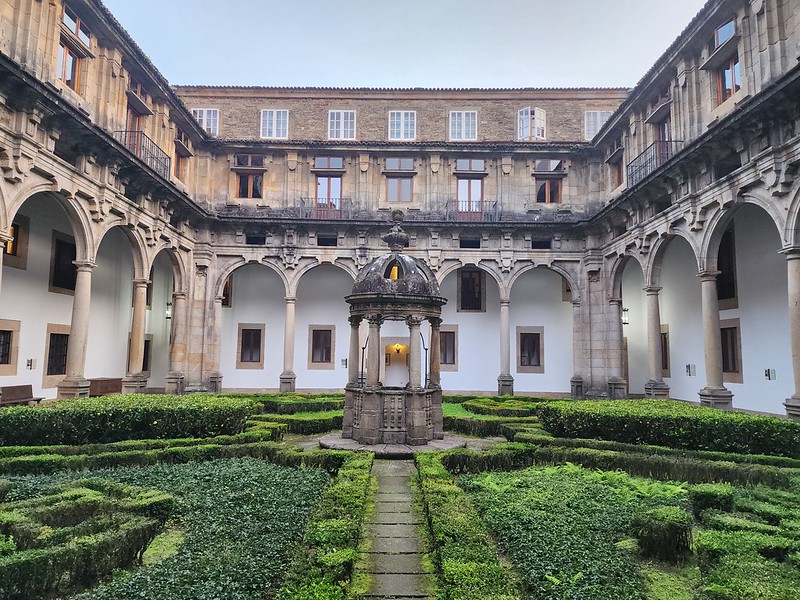
hostal dos reis catolicos
If your budget permits, spend the night at the Hostal dos Reis Catolicos, one of the oldest (if not the oldest) hotel in the world. Built in 1486, it has a distinct medieval look although the rooms are a bit more modest.
End the trip in Santiago de Compostela, just as it serves as the end of the St. James Way. Alternatively, you can also do this trip the other way around and start in Bilbao and end in Santiago.
Getting There
From Singapore, I flew with Turkish Airlines and transited in Istanbul for my onward flight to Barcelona. From Barcelona, I took a domestic flight to Bilbao. Alternatively, Turkish Airlines also flies to Bilbao during certain days via Istanbul, saving one of an extra transit if coming from Singapore or other major Asian capitals.
Internet Connectivity
For trips to Spain or to 49 other countries in Asia-Pacific, USA and Europe, check out Jetpac’s E-Sim which gives you a relatively hefty data allocation of up to 20GB valid for 30 days. Their Globetrotter Plan is usable across multiple destinations so there’s no need to buy another E-Sim plan when crossing to another country as long as it’s within the coverage area. Plus, get free airport lounge access for you and up to 6 companions during flight delays. Find out more here.
This post is written in collaboration with Jetpac

 oujisama
oujisama 












